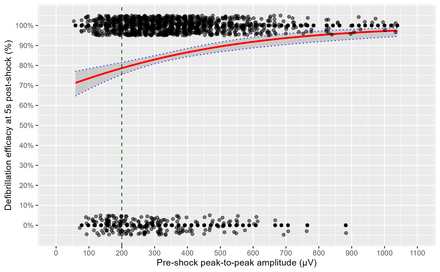Final ID: Su502
Is 80% a Reasonable Minimal Goal for Defibrillation Efficacy of Out-of-Hospital Cardiac Arrest ?
Abstract Body: Introduction
There is no clear goal defined by standards or learned societies on clinical performance related to defibrillation efficacy. In literature, monophasic shocks defibrillation efficacy is mainly >70% whereas biphasic is >80%. Resuscitation guidelines define efficient defibrillation as cessation of shockable rhythm at 5s post-shock and proceed to state that beyond 5s, shock outcomes are biased by known confounders (call to AED connection time (CallAEDTime), bystander, cardio-pulmonary resuscitation (CPR), drugs…). Thus, it is consistent that automated external defibrillator (AED) performance should be assessed in terms of defibrillation efficacy right after the shock rather than in terms of restoration of a spontaneous circulation or survival to hospital discharge. This study aimed to define an acceptable goal for validation of defibrillation efficacy.
Method
In this observational retrospective study, we included AED tracings of adult non-traumatic out-of-hospital cardiac arrest (OHCA) patients with initial ventricular fibrillation (VF) rescued by basic life support teams (Paris Fire Brigade) from 01/2017 to 02/2022. Cardiac rhythm was examined during the 10 first minutes of connection of the AED (DGT7, Schiller Médical, France). Shockable rhythm is defined as coarse-VF with at least 200µV peak-to-peak amplitude (ptpA). Efficient defibrillation was defined as cessation of shockable rhythm at 5s post-shock. We fitted a linear mixed model to predict defibrillation efficacy using the 4s ptpA of pre-shock VF. The model included the patient as random effect and a p-value <0.05 was considered statistically significant.
Results
We analyzed 1333 shocks from 547 patients, with: median age of 59 (interquartile range, IQR[49-71]), 78% male, 36% in public places, 72% with bystander CPR and median[IQR] CallAEDTime of 13min [10-15]min. The effect of the pre-shock ptpA of VF on the defibrillation efficacy is statistically significant: OR=1.023, 95% Confidence Interval (CI) [1.010,1.036], p<0.001. That means that for each 100µv increment in VF amplitude pre-shock, the probability of success at 5s post-shock increases by 2.3%. Adjusting for age, sex, location, CPR and CallAEDTime does not change the results. The logistic regression of Figure1, shows a defibrillation efficacy at 200µV ptpA of 79%, CI [75,82]%.
Conclusion
Based on 1333 OHCA biphasic shocks, this study suggests defining 80% as a reasonable minimal goal for validation of the AED defibrillation efficacy.
There is no clear goal defined by standards or learned societies on clinical performance related to defibrillation efficacy. In literature, monophasic shocks defibrillation efficacy is mainly >70% whereas biphasic is >80%. Resuscitation guidelines define efficient defibrillation as cessation of shockable rhythm at 5s post-shock and proceed to state that beyond 5s, shock outcomes are biased by known confounders (call to AED connection time (CallAEDTime), bystander, cardio-pulmonary resuscitation (CPR), drugs…). Thus, it is consistent that automated external defibrillator (AED) performance should be assessed in terms of defibrillation efficacy right after the shock rather than in terms of restoration of a spontaneous circulation or survival to hospital discharge. This study aimed to define an acceptable goal for validation of defibrillation efficacy.
Method
In this observational retrospective study, we included AED tracings of adult non-traumatic out-of-hospital cardiac arrest (OHCA) patients with initial ventricular fibrillation (VF) rescued by basic life support teams (Paris Fire Brigade) from 01/2017 to 02/2022. Cardiac rhythm was examined during the 10 first minutes of connection of the AED (DGT7, Schiller Médical, France). Shockable rhythm is defined as coarse-VF with at least 200µV peak-to-peak amplitude (ptpA). Efficient defibrillation was defined as cessation of shockable rhythm at 5s post-shock. We fitted a linear mixed model to predict defibrillation efficacy using the 4s ptpA of pre-shock VF. The model included the patient as random effect and a p-value <0.05 was considered statistically significant.
Results
We analyzed 1333 shocks from 547 patients, with: median age of 59 (interquartile range, IQR[49-71]), 78% male, 36% in public places, 72% with bystander CPR and median[IQR] CallAEDTime of 13min [10-15]min. The effect of the pre-shock ptpA of VF on the defibrillation efficacy is statistically significant: OR=1.023, 95% Confidence Interval (CI) [1.010,1.036], p<0.001. That means that for each 100µv increment in VF amplitude pre-shock, the probability of success at 5s post-shock increases by 2.3%. Adjusting for age, sex, location, CPR and CallAEDTime does not change the results. The logistic regression of Figure1, shows a defibrillation efficacy at 200µV ptpA of 79%, CI [75,82]%.
Conclusion
Based on 1333 OHCA biphasic shocks, this study suggests defining 80% as a reasonable minimal goal for validation of the AED defibrillation efficacy.
More abstracts on this topic:
A Systems-Level Intervention Improved Alignment of Initial Hypertension Pharmacotherapy with Clinical Practice Guidelines at a Veterans Affairs Medical Center
Jain Bijal, Dada Adedoyin, Gaddam Meghana, Grabos Lauren, Atoe Eghosa, Escalona Matthew, White Samantha, Rivera Eleanor
Assessing the Impact of Remote Consultation Strategies on Optimizing Guideline-Directed Medical Therapy in Heart Failure Patients: A Meta-AnalysisAlzubi Alhasan Saleh, Mohamed Mohamed Barakat Mohamed, Elfaituri Ahmed, Elhadi Muhammed, S. Beshr Mohammed, Abdelwahed Abdelrahman Farag, Abuajamieh Maram, Elmesherghi Abdulmoez Fauzi, Ekreer Moad, Alawi Zahra Sayed Jalal, Azlitni Muhab, El Awami Mostafa

